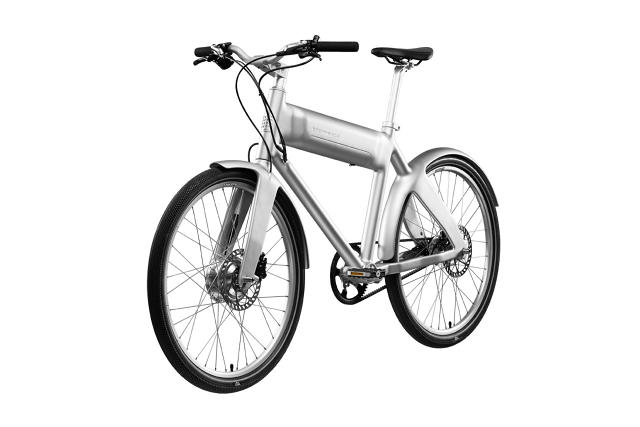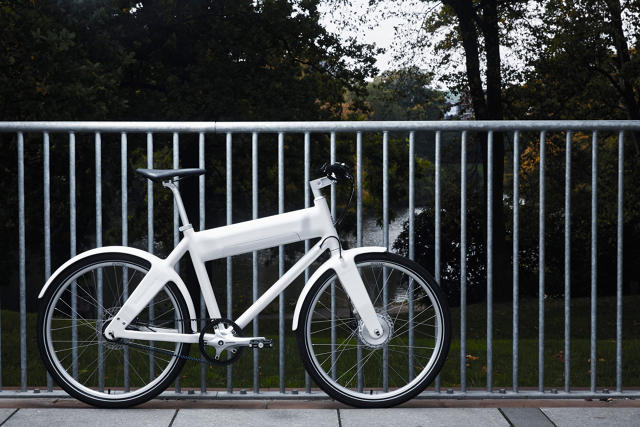Will A Better-Designed Electric Bike Change Commuting Habits? Biomega Thinks So
The OKO by KiBiSi is stealthy, sleek, and has ambitions to change the way you get around cities.
It’s an extreme scenario, but the recent 50-lane carpocalypse in China is a cautionary tale of what happens when there are too many vehicles on the road. And the costs don’t stop at wasted time and frustration. The Economist reports that in Los Angeles, traffic is so bad that each car-driving resident loses around $6,000 a year due to congestion. According to designer and bicycling evangelist Jens Skibsted, the fix lies in two wheels, not four. KiBiSi, the company he co-founded with Bjarke Ingels and Lars Larsen, just launched a handsome new electric bike for Biomega, the OKO, that offers an arresting alternative.
“When it’s rush hour in a city, bikes are on average 40 percent faster than cars,” Skibsted says. However, he doesn’t believe that argument alone—which has been around for years—is compelling enough to convert commuters to daily cyclists. Cars and bikes are still going head to head.

“What form is going to win?” he says. “That’s the fight we’re in. The way bike people want to take that fight is, we’ll make things that work better. That is nonsensical because bikes have been working better than cars for decades—actually centuries. They are much, much faster than cars. They’re already dirt cheap. They don’t pollute. The bike industry would have already won if it was about functionality. So it’s about something else.”
That “something else” is about desire, about an object that speaks to who you are, and about lifestyle. It’s where design enters the equation.
“If the bike industry wants to compete with cars, it needs to be able to assert themselves by creating brands,” Skibsted says, noting that there are just about as many different cars designs on the market as there are personalities in the population. Bicycles, on the flip side, are far more limited. “It’s important that we go into that field and say that there are objects for the self-aware urban dweller that cares about commuting in style and in comfort.”
The OKO features a frame forged from carbon-fiber materials used in Formula 1 race cars. The bike has been engineered so that its 40-pound weight is distributed evenly, unlike most electric bikes which have their motors resting on the rear tire. In fact, you’d be hard pressed to tell that this is an electric bike at all since KiBiSi did an ace job of integrating all of the electrical components—battery, motor, wiring—within the frame. To accomplish the uniform look, Biomega custom manufactured many of the parts specifically for the OKO—down to the pedals—for a uniform presence. A 250-watt motor propels the bike and, depending on how you ride, has a range of about 25 miles per charge. There are two levels of assistance—economy and boost mode—to make pedaling easier. (I took it for a brief spin and the bike flew with just a light tap on the pedal—it couldn’t be easier to ride.)

While electric-powered vehicles were viewed as esoteric, Skibsted says that Tesla and BMW have helped to bring the energy source mainstream and that interest will spill over into biking. “Suddenly electric is seen as something cool,” he says.
Removing some of the sweat factor that goes into bicycle commuting is one reason why electric bikes are appealing from an urban planning perspective. The further away a person lives from their place of work, or the more hilly the terrain, the less likely they are to bike. Skibsted says that cut-off radius is about six miles. Past that, the rate of bicycle commuting dips drastically. “The hope is that an electric bike can extend that circumference,” he says. “Instead of having a six-mile radius, you could have a 12-mile radius. It would really impact how cities are affected by traffic.”

The argument that electric bikes are game-changers when it comes to commuting sounds eerily similar to rationale of Segway champions who, at the time the “personal transporter” hit the market, claimed that it could accomplish at an eco-friendly commute. That future never quite panned out. Could it take a Tesla of e-bikes to make it a reality?
While the OKO certainly has style points over the Segway, one glaring hurdle is still present—bicycling infrastructure and perceived safety. While cities like New York and Copenhagen have a pretty expansive network of bike lanes, that isn’t always the case in other urban areas. And even then, tensions are high between drivers and cyclists. Nearly every bike rider I know speaks of careless drivers cutting them off or opening doors into bike lanes without looking. No matter how good a bicycle looks, those challenges will still be there and will certainly impact the rate of alternative commuting. That said, the feeling of flying by gridlock on a bike is incredibly satisfying.
The OKO by Biomega is available for pre-order from Austere. Shipping is slated for December. Prices start at $2,295.
Fast Company , Read Full Story
(60)














